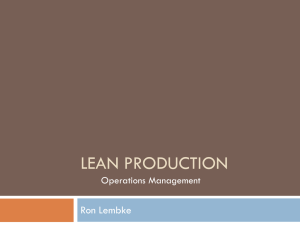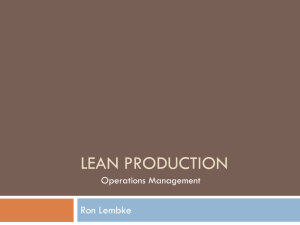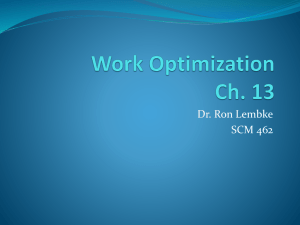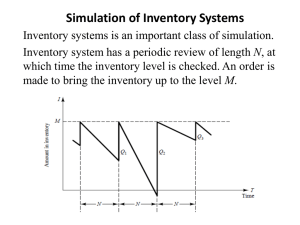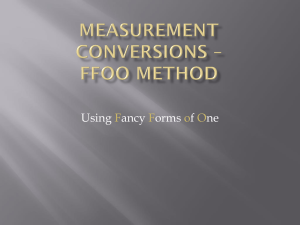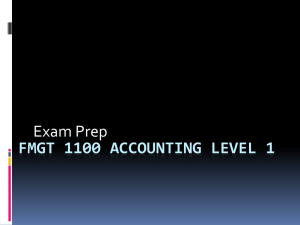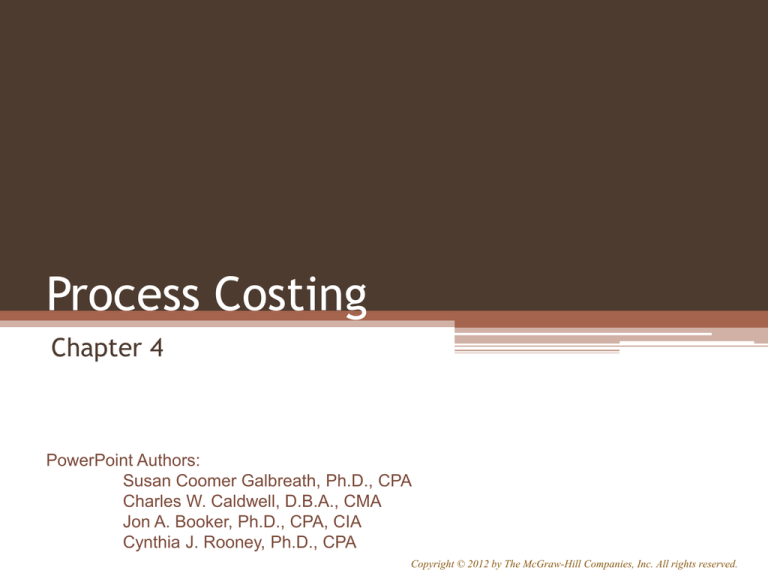
Process Costing
Chapter 4
PowerPoint Authors:
Susan Coomer Galbreath, Ph.D., CPA
Charles W. Caldwell, D.B.A., CMA
Jon A. Booker, Ph.D., CPA, CIA
Cynthia J. Rooney, Ph.D., CPA
Copyright © 2012 by The McGraw-Hill Companies, Inc. All rights reserved.
4-2
Similarities Between Job-Order and
Process Costing
• Both systems assign material, labor, and overhead
costs to products and they provide a mechanism
for computing unit product costs.
• Both systems use the same manufacturing
accounts, including Manufacturing Overhead, Raw
Materials, Work in Process, and Finished Goods.
• The flow of costs through the manufacturing
accounts is basically the same in both systems.
4-3
Differences Between Job-Order and
Process Costing
Process costing:
1. Is used when a single product is produced on a
continuing basis or for a long period of time. Job-order
costing is used when many different jobs having
different production requirements are worked on each
period.
2. Systems accumulate costs by department. Job-order
costing systems accumulated costs by individual jobs.
3. Systems compute unit costs by department. Job-order
costing systems compute unit costs by job on the job
cost sheet.
4-4
Quick Check
Process costing is used for products
that are:
a. Different and produced continuously.
b. Similar and produced continuously.
c. Individual units produced to customer
specifications.
d. Purchased from vendors.
4-5
Quick Check
Process costing is used for products
that are:
a. Different and produced continuously.
b. Similar and produced continuously.
c. Individual units produced to customer
specifications.
d. Purchased from vendors.
4-6
Processing Departments
Any unit in an organization where materials, labor,
or overhead are added to the product.
The activities performed in a processing
department are performed uniformly on all
units of production. Furthermore, the output of
a processing department must be homogeneous.
Products in a process costing environment
typically flow in a sequence from one department
to another.
4-7
Learning Objective 1
Record the flow of
materials, labor, and
overhead through a
process costing system.
4-8
Comparing Job-Order and Process
Costing
Direct
Materials
Direct Labor
Manufacturing
Overhead
Work in
Process
Finished
Goods
Cost of
Goods
Sold
4-9
Comparing Job-Order and Process
Costing
Costs are traced and
applied to individual
jobs in a job-order
cost system.
Direct
Materials
Direct Labor
Manufacturing
Overhead
Jobs
Finished
Goods
Cost of
Goods
Sold
4-10
Comparing Job-Order and Process
Costing
Direct
Materials
Direct Labor
Manufacturing
Overhead
Costs are traced and
applied to departments
in a process cost
system.
Processing
Department
Finished
Goods
Cost of
Goods
Sold
4-11
T-Account and Journal Entry Views of
Process Cost Flows
For purposes of this example, assume
there are two processing departments –
Departments A and B.
We will use T-accounts and journal
entries.
4-12
Process Cost Flows: The Flow of Raw
Materials (in T-account form)
Raw Materials
•Direct
Materials
Work in Process
Department A
•Direct
Materials
Work in Process
Department B
•Direct
Materials
4-13
Process Cost Flows: The Flow of Raw
Materials (in journal entry form)
Work in Process - Department A
XXXXX
Work in Process - Department B
XXXXX
Raw Materials
XXXXX
4-14
Process Cost Flows: The Flow of Labor
Costs (in T-account form)
Salaries and
Wages Payable
•Direct
Labor
Work in Process
Department A
•Direct
Materials
•Direct
Labor
Work in Process
Department B
•Direct
Materials
•Direct
Labor
4-15
Process Costing: The Flow of Labor
Costs (in journal entry form)
Work in Process - Department A
XXXXX
Work in Process - Department B
XXXXX
Salaries and Wages Payable
XXXXX
4-16
Process Cost Flows: The Flow of Manufacturing
Overhead Costs (in T-account form)
Work in Process
Department A
Manufacturing
Overhead
•Actual
Overhead
•Overhead
Applied to
Work in
Process
•Direct
Materials
•Direct
Labor
•Applied
Overhead
Work in Process
Department B
•Direct
Materials
•Direct
Labor
•Applied
Overhead
4-17
Process Cost Flows: The Flow of Manufacturing
Overhead Costs (in journal entry form)
Work in Process - Department A
XXXXX
Work in Process - Department B
XXXXX
Manufacturing Overhead
XXXXX
4-18
Process Cost Flows: Transfers from WIPDept. A to WIP-Dept. B (in T-account form)
Work in Process
Department A
•Direct
Transferred
Materials
to Dept. B
•Direct
Labor
•Applied
Overhead
Department
A
Work in Process
Department B
•Direct
Materials
•Direct
Labor
•Applied
Overhead
•Transferred
from Dept. A
Department
B
4-19
Process Cost Flows: Transfers from WIP-Dept. A
to WIP-Dept. B (in journal entry form)
Work in Process - Department B
Work in Process - Department A
XXXXX
XXXXX
4-20
Process Cost Flows: Transfers from WIP-Dept.
B to Finished Goods (in T-account form)
Work in Process
Department B
•Direct
•Cost of
Materials
Goods
•Direct
Manufactured
Labor
•Applied
Overhead
•Transferred
from Dept. A
Finished Goods
•Cost of
Goods
Manufactured
4-21
Process Cost Flows: Transfers from WIP-Dept.
B to Finished Goods (in journal entry form)
Finished Goods
Work in Process - Department B
XXXXX
XXXXX
4-22
Process Cost Flows: Transfers from Finished
Goods to COGS (in T-account form)
Work in Process
Department B
Finished Goods
•Direct
•Cost of
•Cost of
•Cost of
Materials
Goods
Goods
Goods
•Direct
Manufactured
Manufactured
Sold
Labor
•Applied
Overhead
•Transferred
Cost of Goods Sold
from Dept. A
•Cost of
Goods
Sold
4-23
Process Cost Flows: Transfers from Finished
Goods to COGS (in journal entry form)
Cost of Goods Sold
Finished Goods
XXXXX
XXXXX
4-24
Equivalent Units of Production
Equivalent units are the
product of the number
of partially completed
units and the
percentage completion
of those units.
These partially completed units complicate the
determination of a department’s output for a given
period and the unit cost that should be assigned to
that output.
4-25
Equivalent Units – The Basic Idea
Two half completed products are
equivalent to one complete product.
+
=
1
So, 10,000 units 70% complete
are equivalent to 7,000 complete units.
4-26
Quick Check
For the current period, Jones started 15,000
units and completed 10,000 units, leaving 5,000
units in process 30 percent complete. How
many equivalent units of production did Jones
have for the period?
a. 10,000
b. 11,500
c. 13,500
d. 15,000
4-27
Quick Check
For the current period, Jones started 15,000
units and completed 10,000 units, leaving 5,000
units in process 30 percent complete. How
many equivalent units of production did Jones
have for the period?
a. 10,000
10,000 units + (5,000 units × 0.30)
b. 11,500
= 11,500 equivalent units
c. 13,500
d. 15,000
4-28
Calculating Equivalent Units
Equivalent units can be calculated
two ways:
The First-In, First-Out Method – FIFO is
covered in the appendix to this chapter.
The Weighted-Average Method – This method
will be covered in the main portion of the chapter.
4-29
Learning Objective 2
Compute the equivalent
units of production using
the weighted-average
method.
4-30
Equivalent Units of Production
Weighted-Average Method
The weighted-average method . . .
1. Makes no distinction between work done in prior
or current periods.
2. Blends together units and costs from prior and
current periods.
3. Determines equivalent units of production for a
department by adding together the number of
units transferred out plus the equivalent units in
ending Work in Process Inventory.
4-31
Treatment of Direct Labor
Dollar Amount
Direct
Materials
Manufacturing
Overhead
Direct
Labor
Type of Product Cost
Direct labor costs
may be small
in comparison to
other product
costs in process
cost systems.
4-32
Treatment of Direct Labor
Dollar Amount
Direct
Materials
Conversion
Direct
Labor
Direct
Labor
Type of Product Cost
Manufacturing
Overhead
Direct labor and
manufacturing
overhead may be
combined into
one classification
of product
cost called
conversion costs.
4-33
Weighted-Average – An Example
Smith Company reported the following activity in
the Assembly Department for the month of June:
Percent Completed
Units
Work in process, June 1
300
Units started into production in June
6,000
Units completed and transferred out
of Department A during June
5,400
Work in process, June 30
900
Materials Conversion
40%
20%
60%
30%
4-34
Weighted-Average – An Example
The first step in calculating the equivalent units is to
identify the units completed and transferred out of
Assembly Department in June (5,400 units)
Materials
Units completed and transferred
out of the Department in June
5,400
Conversion
5,400
4-35
Weighted-Average – An Example
The second step is to identify the equivalent units of production in
ending work in process with respect to materials for the month
(540 units) and adding this to the 5,400 units from step one.
Materials
Units completed and transferred
out of the Department in June
5,400
Work in process, June 30:
900 units × 60%
Equivalent units of Production in
the Department during June
540
5,940
Conversion
5,400
4-36
Weighted-Average – An Example
The third step is to identify the equivalent units of production in
ending work in process with respect to conversion for the month
(270 units) and adding this to the 5,400 units from step one.
Materials
Units completed and transferred
out of the Department in June
5,400
Conversion
5,400
Work in process, June 30:
900 units × 60%
540
900 units × 30%
Equivalent units of Production in
the Department during June
270
5,940
5,670
4-37
Weighted-Average – An Example
Equivalent units of production always equals:
Units completed and transferred
+ Equivalent units remaining in work in process
Materials
Units completed and transferred
out of the Department in June
5,400
Conversion
5,400
Work in process, June 30:
900 units × 60%
540
900 units × 30%
Equivalent units of Production in
the Department during June
270
5,940
5,670
4-38
Weighted-Average – An Example
Materials
Beginning
Work in Process
300 Units
40% Complete
6,000 Units Started
5,100 Units Started
and Completed
5,400 Units Completed
540 Equivalent Units
5,940 Equivalent units
of production
Ending
Work in Process
900 Units
60% Complete
900 × 60%
4-39
Weighted-Average – An Example
Conversion
Beginning
Work in Process
300 Units
20% Complete
6,000 Units Started
5,100 Units Started
and Completed
5,400 Units Completed
270 Equivalent Units
5,670 Equivalent units
of production
Ending
Work in Process
900 Units
30% Complete
900 × 30%
4-40
Learning Objective 3
Compute the cost per
equivalent unit using the
weighted-average
method.
4-41
Compute and Apply Costs
Beginning Work in Process Inventory:
400 units
Materials: 40% complete $
6,119
Conversion: 20% complete $
3,920
Production started during June
Production completed during June
Costs added to production in June
Materials cost
Conversion cost
Ending Work in Process Inventory:
Materials:
60% complete
Conversion: 30% complete
6,000 units
5,400 units
$ 118,621
$ 81,130
900 units
4-42
Compute and Apply Costs
The formula for computing the cost per
equivalent unit is:
Cost per
equivalent =
unit
Cost of beginning
Work in Process + Cost added during
Inventory
the period
Equivalent units of production
4-43
Compute and Apply Costs
Here is a schedule with the cost and equivalent
unit information.
Total
Cost
Cost to be accounted for:
Work in process, June 1
Cost added in Assembly
Total cost
Equivalent units
Materials
Conversion
$
10,039
199,751
$
6,119
118,621
$
3,920
81,130
$
209,790
$ 124,740
$
85,050
5,940
5,670
4-44
Compute and Apply Costs
Here is a schedule with the cost and equivalent
unit information.
$124,740 ÷ 5,940 units = $21.00
$85,050 ÷ 5,670 units = $15.00
Total
Cost
Cost to be accounted for:
Work in process, June 1
Cost added in Assembly
Total cost
Materials
Conversion
$
10,039
199,751
$
6,119
118,621
$
3,920
81,130
$
209,790
$ 124,740
$
85,050
Equivalent units
Cost per equivalent unit
5,940
$
21.00
5,670
$
15.00
Cost per equivalent unit = $21.00 + $15.00 = $36.00
4-45
Learning Objective 4
Assign costs to units
using the weightedaverage method.
4-46
Applying Costs
Assembly Department
Cost of Ending WIP Inventory and Units Transferred Out
Materials Conversion
Total
Ending WIP inventory:
Equivalent units
540
270
4-47
Applying Costs
Assembly Department
Cost of Ending WIP Inventory and Units Transferred Out
Materials Conversion
Total
Ending WIP inventory:
Equivalent units
540
270
Cost per equivalent unit
$
21.00
$
15.00
4-48
Applying Costs
Assembly Department
Cost of Ending WIP Inventory and Units Transferred Out
Materials Conversion
Total
Ending WIP inventory:
Equivalent units
540
270
Cost per equivalent unit
$
21.00
$
15.00
Cost of Ending WIP inventory
$ 11,340
$
4,050
$ 15,390
4-49
Computing the Cost of Units
Transferred Out
Assembly Department
Cost of Ending WIP Inventory and Units Transferred Out
Materials Conversion
Total
Ending WIP inventory:
Equivalent units
540
270
Cost per equivalent unit
$
21.00
$
15.00
Cost of Ending WIP inventory
$ 11,340
$
4,050
$ 15,390
Units completed and transferred out:
Units transferred
5,400
5,400
4-50
Computing the Cost of Units
Transferred Out
Assembly Department
Cost of Ending WIP Inventory and Units Transferred Out
Materials Conversion
Total
Ending WIP inventory:
Equivalent units
540
270
Cost per equivalent unit
$
21.00
$
15.00
Cost of Ending WIP inventory
$ 11,340
$
4,050
$ 15,390
Units completed and transferred out:
Units transferred
5,400
5,400
Cost per equivalent unit
$
21.00
$
15.00
4-51
Computing the Cost of Units
Transferred Out
Assembly Department
Cost of Ending WIP Inventory and Units Transferred Out
Materials Conversion
Total
Ending WIP inventory:
Equivalent units
540
270
Cost per equivalent unit
$
21.00
$
15.00
Cost of Ending WIP inventory
$ 11,340
$
4,050
$ 15,390
Units completed and transferred out:
Units transferred
5,400
5,400
Cost per equivalent unit
$
21.00
$
15.00
Cost of units transferred out
$ 113,400
$ 81,000
$ 194,400
4-52
Learning Objective 5
Prepare a cost
reconciliation report.
4-53
Reconciling Costs
Assembly Department
Cost Reconciliation
Costs to be accounted for:
Cost of beginning Work in Process Inventory
Costs added to production during the period
Total cost to be accounted for
$
$
10,039
199,751
209,790
4-54
Reconciling Costs
Assembly Department
Cost Reconciliation
Costs to be accounted for:
Cost of beginning Work in Process Inventory
Costs added to production during the period
Total cost to be accounted for
Cost accounted for as follows:
Cost of ending Work in Process Inventory
Cost of units transferred out
Total cost accounted for
$
$
$
$
10,039
199,751
209,790
15,390
194,400
209,790
4-55
Operation Costing
Operation cost is a hybrid of job-order and
process costing because it possesses
attributes of both approaches.
Operation costing is
commonly used when
batches of many
different products pass
through the same
processing department.
FIFO Method
Appendix 4A
PowerPoint Authors:
Susan Coomer Galbreath, Ph.D., CPA
Charles W. Caldwell, D.B.A., CMA
Jon A. Booker, Ph.D., CPA, CIA
Cynthia J. Rooney, Ph.D., CPA
Copyright © 2012 by The McGraw-Hill Companies, Inc. All rights reserved.
4-57
FIFO vs. Weighted-Average Method
The FIFO method (generally considered more
accurate than the weighted-average method) differs
from the weighted-average method in two ways:
1. The computation of equivalent units.
2. The way in which the costs of beginning
inventory are treated.
4-58
Learning Objective 6
Compute the equivalent
units of production using
the FIFO method.
4-59
Equivalent Units – FIFO Method
Let’s revisit the Smith Company example. Here is
information concerning the Assembly Department
for the month of June.
Percent Completed
Units
Work in process, June 1
300
Units started into production in June
6,000
Units completed and transferred out
of Department A during June
5,400
Work in process, June 30
900
Materials Conversion
40%
20%
60%
30%
4-60
Equivalent Units – FIFO Method
Step 1: Determine equivalent units needed to complete
beginning Work in Process Inventory.
Materials
To complete beginning Work in Process:
Materials: 300 units × (100% - 40%)
Conversion: 300 units × (100% - 20%)
Conversion
180
240
4-61
Equivalent Units – FIFO Method
Step 2: Determine units started and completed during
the period.
Materials
To complete beginning Work in Process:
Materials: 300 units × (100% - 40%)
180
Conversion: 300 units × (100% - 20%)
Units started and completed during June
Conversion
240
5,100
5,100
4-62
Equivalent Units – FIFO Method
Step 3: Add the equivalent units in ending Work in
Process Inventory.
Materials
To complete beginning Work in Process:
Materials: 300 units × (100% - 40%)
180
Conversion: 300 units × (100% - 20%)
Units started and completed during June
Conversion
240
5,100
5,100
Ending Work in Process
Materials: 900 units × 60% complete
Conversion: 900 units × 30% complete
Equivalent units of production
540
270
5,820
5,610
4-63
FIFO Example
Materials
Beginning
Work in Process
300 Units
40% Complete
300 × 60%
6,000 Units Started
5,100 Units Started
and Completed
180 Equivalent Units
5,100 Units Completed
540 Equivalent Units
5,820 Equivalent units
of production
Ending
Work in Process
900 Units
60% Complete
900 × 60%
4-64
FIFO Example
Conversion
Beginning
Work in Process
300 Units
20% Complete
300 × 80%
6,000 Units Started
5,100 Units Started
and Completed
240 Equivalent Units
5,100 Units Completed
270 Equivalent Units
5,610 Equivalent units
of production
Ending
Work in Process
900 Units
30% Complete
900 × 30%
4-65
Equivalent Units:
Weighted-Average vs. FIFO
As shown below, the equivalent units in beginning inventory are
subtracted from the equivalent units of production per the
weighted-average method to obtain the equivalent units of
production under the FIFO method.
Equivalent units - weighted-average method
Less equivalent units in beginning inventory:
300 units × 40%
300 units × 20%
Equivalent units - FIFO method
Materials
5,940
Conversion
5,670
120
5,820
60
5,610
4-66
Learning Objective 7
Compute the cost per
equivalent unit using the
FIFO method.
4-67
Cost per Equivalent Unit - FIFO
Let’s revisit the Smith Company Assembly Department
for the month of June to prepare our production report.
Beginning work in process:
Materials: 40% complete
Conversion: 20% complete
$
$
400 units
6,119
3,920
Production started during June
Production completed during June
6,000 units
5,400 units
Costs added to production in June
Materials cost
Conversion cost
$ 118,621
$ 81,130
Ending work in process
Materials:
60% complete
Conversion: 30% complete
900 units
4-68
Cost per Equivalent Unit - FIFO
The formula for computing the cost per
equivalent unit under FIFO method is:
Cost per
equivalent =
unit
Cost added during the period
Equivalent units of production
4-69
Cost per Equivalent Unit - FIFO
Total
Cost
Cost added in June
Equivalent units
$ 199,751
Cost per equivalent unit
$118,621 ÷ 5,820
Materials
Conversion
$ 118,621
5,820
$
$ 20.3816
$ 14.4617
81,130
5,610
$81,130 ÷ 5,610
Total cost per equivalent unit = $20.3816 + $14.4617 = $34.8433
4-70
Learning Objective 8
Assign costs to units
using the FIFO method.
4-71
Applying Costs - FIFO
Step 1: Record the equivalent units of production in ending Work
in Process Inventory.
Assembly Department
Cost of Ending WIP Inventory
Materials Conversion
Ending WIP inventory:
Equivalent units
540
900 units × 60%
270
900 units × 30%
Total
4-72
Applying Costs - FIFO
Step 2: Record the cost per equivalent unit.
Assembly Department
Cost of Ending WIP Inventory
Materials Conversion
Ending WIP inventory:
Equivalent units
Cost per equivalent unit
540
$ 20.3816
270
$ 14.4617
Total
4-73
Applying Costs - FIFO
Step 3: Compute the cost of ending Work in Process Inventory.
Assembly Department
Cost of Ending WIP Inventory
Materials Conversion
Ending WIP inventory:
Equivalent units
Cost per equivalent unit
Cost of Ending WIP inventory
540
$ 20.3816
$ 11,006
540 × $20.3816
270
$ 14.4617
$
3,905
270 × 14.4617
Total
$
14,911
4-74
Cost of Units Transferred Out
Step 1: Record the cost in beginning Work in Process Inventory.
Assembly Department
Cost of Units Transferred Out in June
Materials
Conversion
Cost of Units Transferred Out:
Cost in beginning WIP inventory
$
6,119
$
3,920
Cost to complete beginning WIP
Equivalent units to complete
180
240
Cost per equivalent unit
$ 20.3816
$ 14.4617
Cost to complete beginning WIP
$
3,669
$
3,471
Cost of units started and completed:
Units started and completed
5,100
5,100
Cost per equivalent unit
$ 20.3816
$ 14.4617
Cost of units started and completed
$ 103,946
$ 73,755
Cost of Units Transferred Out
Total
$
10,039
7,140
177,701
$ 194,880
4-75
Cost of Units Transferred Out
Step 2: Compute the cost to complete the units in beginning
Work in Process Inventory.
Assembly Department
Cost of Units Transferred Out in June
Materials
Conversion
Cost of Units Transferred Out:
Cost in beginning WIP inventory
$
6,119
$
3,920
Cost to complete beginning WIP
Equivalent units to complete
180
240
Cost per equivalent unit
$ 20.3816
$ 14.4617
Cost to complete beginning WIP
$
3,669
$
3,471
Cost of units started and completed:
Units started and completed
5,100
5,100
Cost per equivalent unit
$ 20.3816
$ 14.4617
Cost of units started and completed
$ 103,946
$ 73,755
Cost of Units Transferred Out
Total
$
10,039
7,140
177,701
$ 194,880
4-76
Cost of Units Transferred Out
Step 3: Compute the cost of units started and completed this
period.
Assembly Department
Cost of Units Transferred Out in June
Materials
Conversion
Cost of Units Transferred Out:
Cost in beginning WIP inventory
$
6,119
$
3,920
Cost to complete beginning WIP
Equivalent units to complete
180
240
Cost per equivalent unit
$ 20.3816
$ 14.4617
Cost to complete beginning WIP
$
3,669
$
3,471
Cost of units started and completed:
Units started and completed
5,100
5,100
Cost per equivalent unit
$ 20.3816
$ 14.4617
Cost of units started and completed
$ 103,946
$ 73,755
Cost of Units Transferred Out
Total
$
10,039
7,140
177,701
$ 194,880
4-77
Cost of Units Transferred Out
Step 4: Compute the total cost of units transferred out.
Assembly Department
Cost of Units Transferred Out in June
Materials
Conversion
Cost of Units Transferred Out:
Cost in beginning WIP inventory
$
6,119
$
3,920
Cost to complete beginning WIP
Equivalent units to complete
180
240
Cost per equivalent unit
$ 20.3816
$ 14.4617
Cost to complete beginning WIP
$
3,669
$
3,471
Cost of units started and completed:
Units started and completed
5,100
5,100
Cost per equivalent unit
$ 20.3816
$ 14.4617
Cost of units started and completed
$ 103,946
$ 73,755
Cost of Units Transferred Out
Total
$
10,039
7,140
177,701
$ 194,880
4-78
Learning Objective 9
Prepare a cost
Prepare a cost
reconciliation report
reconciliation report
using the FIFO method.
using the FIFO method.
4-79
Reconciling Costs
Assembly Department
Cost Reconciliation for June
Costs to be accounted for:
Cost of beginning Work in Process Inventory
Costs added to production during the period
Total cost to be accounted for
Cost accounted for as follows:
Cost of ending Work in Process Inventory
Cost of units transferred out
Total cost accounted for*
$
$
$
$
10,039
199,751
209,790
14,911
194,880
209,791
4-80
Reconciling Costs
Assembly Department
Cost Reconciliation for June
Costs to be accounted for:
Cost of beginning Work in Process Inventory
Costs added to production during the period
Total cost to be accounted for
Cost accounted for as follows:
Cost of ending Work in Process Inventory
Cost of units transferred out
Total cost accounted for*
* $1 rounding error.
$
$
$
$
10,039
199,751
209,790
14,911
194,880
209,791
4-81
A Comparison of Costing Methods
In a lean production environment, FIFO and
weighted-average methods yield similar
unit costs.
When considering cost control, FIFO is
superior to weighted-average because it
does not mix costs of the current period with
costs of the prior period.
Service Department Allocations
Appendix 4B
PowerPoint Authors:
Susan Coomer Galbreath, Ph.D., CPA
Charles W. Caldwell, D.B.A., CMA
Jon A. Booker, Ph.D., CPA, CIA
Cynthia J. Rooney, Ph.D., CPA
Copyright © 2012 by The McGraw-Hill Companies, Inc. All rights reserved.
4-83
End of Chapter 4



